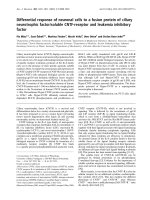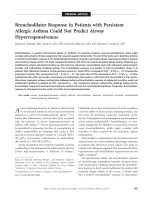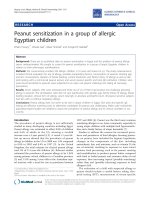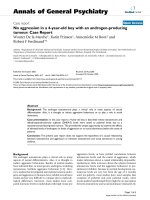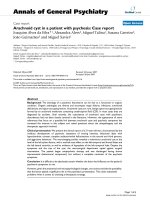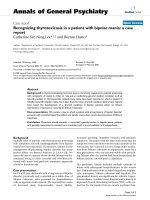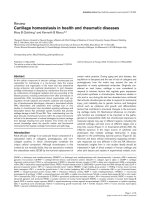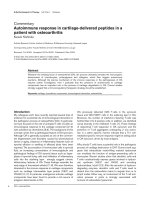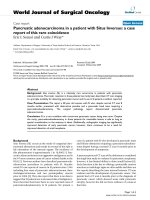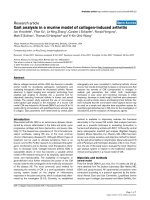Báo cáo y học: "Autoimmune response in cartilage-delivered peptides in a patient with osteoarthritis" pptx
Bạn đang xem bản rút gọn của tài liệu. Xem và tải ngay bản đầy đủ của tài liệu tại đây (33.62 KB, 2 trang )
6
OA = osteoarthritis.
Arthritis Research & Therapy Vol 6 No 1 Nishioka
Introduction
My colleagues and I have recently reported several lines of
evidence for a potential role of immunological intervention in
the pathogenic process of osteoarthritis (OA). In particular,
we have focused on the role of activated T cells [1] after an
immunological response to the cartilage component [2–4]
with activation by chemokines [5,6]. The background of this
concept comes from a pathological feature of OA synovium.
Although OA is generally accepted as one of the common-
est degenerative joint disorders caused by biomechanical
stress or aging, instances of inflammatory features such as
synovial effusion or swelling of affected joints have been
reported. The accumulation of mononuclear cells in synovial
fluid, an increasing concentration of immunoglobulin and
pathological findings of OA synovial tissue such as hyper-
plasia of synovial lining cells and infiltration of inflammatory
cells into the sublining layer strongly suggest chronic
inflammatory features of OA. These findings resemble the
early stage of rheumatoid arthritis [7–9]. We were therefore
interested in the immune response to cartilage components
such as cartilage intermediate layer protein (CILP) and
YKL39 [10,11]. In particular, endogenous articular cartilage
components have been found to provide a rich source of
antigenic determinants in OA.
We previously detected CD3 T cells in the synovium
tissue and CD4
+
CD8
+
cells in the sublining layer in OA.
Moreover, the number of interferon-γ-bearing T cells was
fivefold that of IL-4-positive cells. In addition, we identified
clonal diversity in the infiltrated T cells [1]. These findings
of oligoclonal T cell expansion in OA synovium and the
presence of T cell aggregates undergoing in situ activa-
tion in a rather specific manner indicate that a Th1 cell-
mediated specific immune response might be taking place
in OA synovium, driven by local antigens.
Why should T cells have a potential role in the pathogenic
process of cartilage destruction in OA? Current work sug-
gests that extracellular matrix-filling material hyaluronan
can modulate the function of antigen-presenting cells in
monocytes. Recent studies show that dendritic cells and
T cells constitutionally express genes involved in hyaluro-
nan synthesis (HAS1 and HAS3) and encoding
hyaluronidase, Hyal3 [12]. After the secretion of hyaluron-
degrading enzymes, dendritic cells and T cells need to
detach from the extracellular matrix to migrate from or to
lymph nodes. Either way, an involvement of the T cell acti-
vation process in joints is strongly associated with
turnover of extracellular hyaluronan.
Commentary
Autoimmune response in cartilage-delivered peptides in a
patient with osteoarthritis
Kusuki Nishioka
Arthritis Research Centre, Institute of Medicine, St Marianna University, Kawasaki, Japan
Corresponding author: Kusuki Nishioka (e-mail: )
Received: 7 Jul 2003 Accepted: 22 Oct 2003 Published: 5 Dec 2003
Arthritis Res Ther 2004, 6:6-7 (DOI 10.1186/ar1025)
© 2004 BioMed Central Ltd (Print ISSN 1478-6354; Online ISSN 1478-6362)
Abstract
Whatever the initiating factor of osteoarthritis (OA), the process ultimately unmasks the immunogenic
determinants of chondrocytes, proteoglycans and collagens, which then triggers autoimmune
reactions. Although the precise mechanism of the immune responses in the pathogenesis of OA
requires further investigation, here I postulate that the presence of autoimmunity to cartilage
components has an important role in the process of cartilage degradation in OA. Current studies
strongly suggest that a immunoregulatory therapeutic strategy should be established.
Keywords: cartilage, chemokines, components, immunological intervention, osteoarthritis
7
Available online />In conclusion, I would like to emphasize that examining the
potential role of T cells and autoantibody against cartilage
components in OA has been instrumental in developing
not only new insights into the pathogenesis of OA but also
novel strategies for the treatment of OA, such as the appli-
cation of an immunomodulative agent.
Competing interests
None declared.
References
1. Nakamura H, Yoshino S, Kato T, Tsuruha J, Nishioka K: T-cell
mediated inflammatory pathway in osteoarthritis. Osteoarthri-
tis Cartilage 1999, 7:401-402.
2. Tsuruha J, Masuko-Hongo K, Kato T, Sakata M, Nakamura H,
Nishioka K: Implication of cartilage intermediate layer protein
in cartilage destruction in subsets of patients with
osteoarthritis and rheumatoid arthritis. Arthritis Rheum 2001,
44:838-845.
3. Sekine T, Masuko-Hongo K, Matsui T, Asahara H, Takigawa M,
Nishioka K, Kato T: Recognition of YKL-39, a human cartilage
related protein, as a target antigen in patients with rheuma-
toid arthritis. Ann Rheum Dis 2001, 60:49-54.
4. Sakata M, Tsuruha JI, Masuko-Hongo K, Nakamura H, Matsui T,
Sudo A, Nishioka K, Kato T: Autoantibodies to osteopontin in
patients with osteoarthritis and rheumatoid arthritis. J
Rheumatol 2001, 28:1492-1495.
5. Yuan GH, Masuko-Hongo, Nishioka K: Role of chemokines/
chemokine receptor systems in cartilage degradation. Drug
News Perspect 2001, 14:591-600.
6. Yuan GH, Masuko-Hongo K, Sakata M, Tsuruha J, Onuma H,
Nakamura H, Aoki H, Kato T, Nishioka K: The role of C-C
chemokines and their receptors in osteoarthritis. Arthritis
Rheum 2001, 44:1056-1070.
7. Peyron J: Inflammation of osteoarthritis (OA): review of its role
in clinical picture, disease progress, subsets and pathophysi-
ology. Semin Arthritis Rheum 1980, Suppl 1:115-116.
8. Pelletier JP, Martel-Pelletier J, Abramson SB: Osteoarthritis, an
inflammatory disease: potential implication for the selection
of new therapeutic targets. Arthritis Rheum 2001, 44:1237-
1247.
9. Golderg DL, Egan MS, Cohen AS: Inflammatory synovitis in
degenerative joint disease. J Rheumatol 1982, 9:204-209.
10. Poole AR: Immunology of cartilage. In: Osteoarthritis: Diagnosis
and Medical/Surgical Management. 2nd edition. Edited by
Moskowitz RW, Howell DS, Goldberg VM, Mankin HJ. Philadel-
phia: WB Saunders; 1992:155-189.
11. Banerjee S, Poole AR: Immunity to cartilage proteoglycans. J
Rheumatol 1992, 33 (Suppl):36-39.
12. Christian T, Jonathan PS, Jan CS: Hyaluronan – magic glue for
the regulation of the immune response? Trends Immunol
2003, 24:112-114.
Correspondence
Kusuki Nishioka, MD, Arthritis Research Centre, Institute of Medicine,
St Marianna University, 2-16-1 Sugao Miyamae-ku, Kawasaki 216-
8512, Japan. Tel: +81 44 977 8111; fax: +81 44 977 9165; e-mail:
